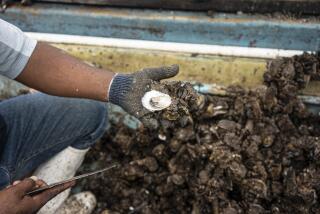Shipshape Trips Require Planning : While the chance of becoming ill from tainted food on a cruise is remote, precautions can be taken.
- Share via
Life aboard a cruise ship can turn grim quickly when illness attacks cabin after cabin.
Three hundred passengers and crew recently learned that firsthand, when a gastrointestinal illness swept through two successive American Hawaii cruises, forcing its SS Independence out of service temporarily. Investigation of the outbreaks is continuing by the federal Centers for Disease Control, whose investigators speculate that contaminated food or water is to blame.
Fortunately, such incidents are relatively rare, according to Thomas Hunt, chief of the vessel sanitation program for CDC. Over the past three years, he can recall only three outbreaks of food-borne illness on the 120 ships monitored. “The risk is declining and overall inspection scores on the ships are increasing,” Hunt said. “The risk of having a gastrointestinal disease (from contaminated food) is less on a cruise ship than at a local restaurant.”
Even so, shipboard illness does occur. Most likely to strike, experts say, are viral and bacterial illnesses commonly referred to as “food poisoning” or turista , urinary tract infections and sexually transmitted diseases. Less common aboard cruise ships are widespread influenza and other viral diseases, but the close quarters can make those illnesses spread faster than usual, according to Dr. Ellie J.C. Goldstein, an infectious disease specialist at St. John’s Hospital and Health Center in Santa Monica.
Yet there’s much a passenger can do to minimize the risk of such problems while afloat, beginning with the wise selection of a cruise line.
- Select a ship with a good inspection record.
Ships that include foreign itineraries and call on United States ports are inspected twice a year by the federal Centers for Disease Control, which works with state and local health officials, according to Linda Anderson, CDC’s chief of special programs. Ships failing one inspection must then undergo a second.
“Inspections are centered around food and water, similar to what a land-based restaurant would receive,” Hunt explained.
Prospective passengers can obtain the latest CDC inspection score and report on a specific ship. Or they can ask for a free “green sheet”: a listing of scores for all ships inspected. (Write to Chief, Vessel Sanitation Program, 1015 N. America Way, Room 107, Miami, Fla. 33132.)
Prospective passengers on American Hawaii cruises can obtain the line’s inspection scores, at no charge, from the Hawaii Department of Health, Sanitation Branch, 591 Ala Moana Blvd., Honolulu, Hawaii 96813. Since American Hawaii does not call on foreign ports, it is inspected by state health officials and the Food and Drug Admin.
In the wake of the recent outbreak on the SS Independence, American Hawaii is now required to follow several new regulations, said Jennifer Styer, a Health Department spokeswoman. The line must train all food handlers in routine sanitation methods. And the company’s 24-hour limit on employee sick leaves during cruises has been abolished. In addition, the cruise line has been directed to admit health department officials for unscheduled inspections within five minutes of their arrival at the ship.
Epidemiologists from CDC and the Hawaii Department of Health are still investigating the SS Independence outbreak, Styer said, with the final report expected in a few months.
* Use common sense in food selection on board and while ashore.
Since even ships with good sanitation records can slip, careful choice of food is a must. “Stay away from uncooked or undercooked meats,” Goldstein suggests. “You could pick up toxoplasmosis (an infection that can be particularly dangerous in pregnant women) from eating undercooked meat. You could get salmonella or Campylobacter (bacteria that can lead to gastroenteritis or food poisoning).”
Avoid creamy foods that look as if they’ve been standing out for a while, suggests Dr. Stephen Brunton, director of family medicine at Long Beach Memorial Medical Center, and a former cruise ship physician. That may mean passing up the chocolate cream pie at the midnight buffet, as well as entrees in cream sauce at dinner. “Creamy foods left to stand are terrific mediums for germs,” Brunton said.
Once in port, exercise even more caution in your eating habits. “Be careful (what you eat) off the ship,” Goldstein advised. Don’t sample street fare no matter how tempting it looks. Don’t eat raw seafood, experts caution, including such delicacies as raw oysters.
“Avoid lettuce, tomatoes, things washed in water,” Brunton said. “Don’t drink the water--and that includes the ice. Freezing does not kill the bacteria.” In lieu of mixed drinks, consider beer or bottled water.
So-called “travelers’ diarrhea,” caused by Escherichia coli bacteria, is the one of the most common causes of diarrheal illness in cruise ship passengers, said Goldstein and others. “It can take two to five days after ingestion to come down with symptoms,” Goldstein said, and often, the contaminated food is eaten ashore. Most people contract it in a mild form, necessitating confinement to the cabin for an afternoon or so. A small percentage of people complain that symptoms go on for a day or two. About 20% come down with moderate to severe symptoms and need medical help for relief of abdominal pain, gas, diarrhea and dehydration.
Taking antibiotics before a cruise to prevent travelers’ diarrhea may sound wise, but Goldstein doesn’t recommend it, in general, because the bacteria can become resistant through prophylactic use. Once travelers’ diarrhea strikes, though, antibiotics can help those with moderate to severe symptoms, he said.
Taking Pepto-Bismol tablets can be an effective preventive measure. Goldstein advises chewing on four a day. “That will prevent turista , but it will turn stools black. It will decrease the incidence; it doesn’t totally prevent it.” Only short-term use, two weeks or less, is recommended, he stresses.
Simple hygiene can also minimize disease risk, said Dr. Richard Besser, a CDC epidemiologist. Washing hands before eating and after bathroom use can help, he said.
* Plan ahead to prevent or minimize other potential health problems.
Antibiotics are the usual treatment for urinary tract infections, Goldstein said. Women who know they are prone to the condition might consider asking their doctor before a trip about a preventive antibiotic course.
Among couples, sexually transmitted diseases can occur. “Any sexual activity carries the risk of STDs,” said Goldstein, who recommends use of a latex condom and other safe sex practices. Besides AIDS, chlamydial infections and, less frequently, gonorrhea can occur.
Other common illnesses, such as colds and flu, can spread faster in close quarters on ship. “Stay away from anyone coughing and sick,” Goldstein suggests. Elderly people and those with chronic medical problems, such as high blood pressure, should be aware that the “cruise lifestyle” that usually includes overeating and over drinking might worsen their symptoms. Heartburn can increase after overeating on cruises, Brunton notes, so taking along antacids is wise.
* Assemble a first-aid kit. Goldstein and Brunton recommend the following: sun block (SPF of 15 or greater); sunburn remedy, such as calamine lotion; laxative; anti-diarrheal remedy; antacid; bandages; antibacterial spray or ointment; aspirin or acetaminophen; Pepto-Bismol tablets and insect repellent. And ask your physician if you should take along other medications, such as preventive antibiotics, extra amounts of regular prescription medications or seasickness remedies.
More to Read
Sign up for The Wild
We’ll help you find the best places to hike, bike and run, as well as the perfect silent spots for meditation and yoga.
You may occasionally receive promotional content from the Los Angeles Times.






